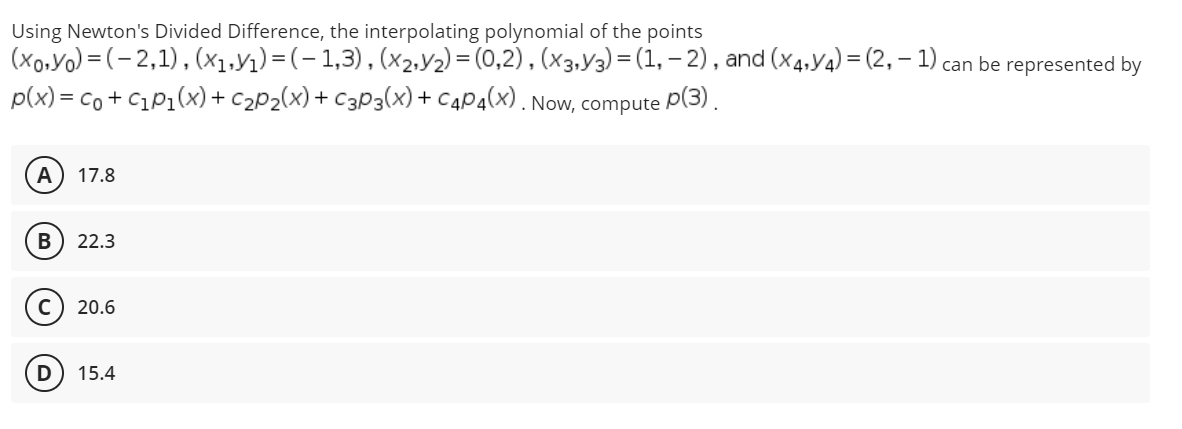Using Newton's Divided Difference, the interpolating polynomial of the points (xo.Yo) = (- 2,1), (x1,V1) = (- 1,3) , (x2.y2) = (0,2), (x3,Y3) = (1, – 2), and (x4.Y4) = (2,– 1), p(x) = co + C1P1(x)+ c2P2(x) + C3P3(x) + C4Pa(x). Now, compute P(3). can be represented by A 17.8 В 22.3 20.6 15.4
Using Newton's Divided Difference, the interpolating polynomial of the points (xo.Yo) = (- 2,1), (x1,V1) = (- 1,3) , (x2.y2) = (0,2), (x3,Y3) = (1, – 2), and (x4.Y4) = (2,– 1), p(x) = co + C1P1(x)+ c2P2(x) + C3P3(x) + C4Pa(x). Now, compute P(3). can be represented by A 17.8 В 22.3 20.6 15.4
Algebra & Trigonometry with Analytic Geometry
13th Edition
ISBN:9781133382119
Author:Swokowski
Publisher:Swokowski
Chapter9: Systems Of Equations And Inequalities
Section9.5: Systems Of Linear Equations In More Than Two Variables
Problem 44E
Related questions
Question

Transcribed Image Text:Using Newton's Divided Difference, the interpolating polynomial of the points
(xo,Yo) = (- 2,1),(x1,yı)=(-1,3), (x2,y2) = (0,2) , (x3,Y3) = (1, – 2) , and (x4,Y4) = (2, – 1) can be represented by
p(x) = co + C1P1(x)+ c2P2(x)+ C3P3(x) + C4P4(x) . Now, compute P(3).
A
17.8
22.3
c) 20.6
15.4
Expert Solution
This question has been solved!
Explore an expertly crafted, step-by-step solution for a thorough understanding of key concepts.
Step by step
Solved in 2 steps with 3 images

Recommended textbooks for you

Algebra & Trigonometry with Analytic Geometry
Algebra
ISBN:
9781133382119
Author:
Swokowski
Publisher:
Cengage

Trigonometry (MindTap Course List)
Trigonometry
ISBN:
9781337278461
Author:
Ron Larson
Publisher:
Cengage Learning

Algebra & Trigonometry with Analytic Geometry
Algebra
ISBN:
9781133382119
Author:
Swokowski
Publisher:
Cengage

Trigonometry (MindTap Course List)
Trigonometry
ISBN:
9781337278461
Author:
Ron Larson
Publisher:
Cengage Learning